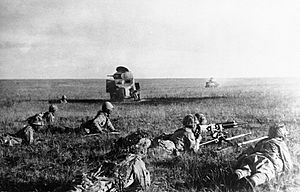Battle of Khalkhin Gol facts for kids
Quick facts for kids Battles of Khalkhin Gol/Nomonhan |
|||||||||
|---|---|---|---|---|---|---|---|---|---|
| Part of the Soviet–Japanese border conflicts | |||||||||
 Japanese infantrymen near wrecked USSR armored vehicles, July 1939 |
|||||||||
|
|||||||||
| Belligerents | |||||||||
| Commanders and leaders | |||||||||
|
|||||||||
| Strength | |||||||||
|
61,860–73,961
4,000 trucks 1,921 horses and camels (Mongol only) |
c. 20,000–30,000
1,000 trucks 2,708 horses |
||||||||
| Casualties and losses | |||||||||
| Manpower: Equipment: 208 aircraft 253 tanks destroyed 133 armored cars destroyed 96 mortars and artillery 49 tractors and prime movers 652 trucks and other motor vehicles significant animal casualties |
Manpower: Equipment: 160 aircraft 29 tanks destroyed or crippled Many tankettes destroyed 72 artillery pieces (field guns only) 2,330 horses killed, injured, or sick significant motor vehicle losses |
||||||||
The Battles of Khalkhin Gol were a series of important fights that happened in 1939. They took place near the Khalkhin Gol river, in an area between Mongolia and Manchuria (which is now part of China). These battles were fought between the Soviet Union and Mongolia on one side, and Japan and its ally Manchukuo on the other. The fighting lasted from May 11 to September 16, 1939. In the end, the Soviet and Mongolian forces won, and a ceasefire agreement was signed.
Contents
Why Did the Battles Happen?
The main reason for the fighting was a disagreement over borders. Japan, which controlled Manchuria, believed the border was along the Khalkhin Gol river. However, Mongolia and the Soviet Union thought the border was further east. This difference in opinion led to many small clashes, which then grew into larger battles. Both sides wanted to control this important area.
Who Was Involved in the Fighting?
On one side were the forces of the Soviet Union and the Mongolian People's Republic. Their main commanders included Georgy Zhukov, who later became a very famous Soviet general. On the other side were the armies of Japan and Manchukuo. Manchukuo was a state in Manchuria that Japan had set up.
What Were the Main Forces?
The Soviet and Mongolian forces had a lot of soldiers, tanks, armored cars, and aircraft. They also used many trucks to move supplies. The Japanese and Manchukuo forces were smaller in number. They had fewer tanks and aircraft, but their soldiers were known for being very determined.
How Did the Battles Unfold?
The fighting started in May 1939 with small clashes. Japanese forces crossed the disputed border. The Soviet and Mongolian armies responded quickly. The battles became very intense, with both sides using tanks, planes, and artillery.
Early Skirmishes and Air Battles
In May, there were many small fights. Both sides sent planes into the sky. The Japanese pilots were very skilled, but the Soviet air force eventually gained control of the air. This was important because it allowed Soviet planes to support their ground troops.
Major Ground Attacks
In July, Japanese forces launched a big attack. They tried to push the Soviet and Mongolian troops back across the river. However, the Soviet forces, led by General Zhukov, held their ground. They used their tanks and artillery to stop the Japanese advance.
The Soviet Counterattack
In August, the Soviet Union launched a massive surprise attack. They used a lot of tanks, armored cars, and infantry. They surrounded the Japanese forces. This was a very clever plan that caught the Japanese by surprise. The fighting was fierce, but the Japanese forces were trapped.
What Happened After the Counterattack?
Many Japanese soldiers were surrounded and had no way to escape. They fought bravely, but they were eventually defeated. This big Soviet victory effectively ended the main fighting.
What Was the Outcome?
The Soviet Union and Mongolia won the Battles of Khalkhin Gol. A ceasefire agreement was signed on September 16, 1939. This agreement confirmed the border that Mongolia and the Soviet Union had claimed.
Why Was This Battle Important?
- Border Settled: The battles helped settle the border dispute between Mongolia and Manchuria.
- Lessons for War: The Soviet Union learned important lessons about how to use tanks and air power together. These lessons were very useful later in World War II.
- Japan's Focus: After this defeat, Japan decided not to expand its empire further north into the Soviet Union. Instead, they turned their attention south, which later led to conflicts with other countries.
- Zhukov's Rise: General Zhukov became famous for his leadership in these battles. He later played a key role in defeating Nazi Germany in World War II.
Images for kids
-
Grigori Shtern, Khorloogiin Choibalsan and Georgy Zhukov at Khalkhin Gol
-
Russian President Dmitry Medvedev and Mongolian President Tsakhiagiin Elbegdorj standing in front of a statue of Zhukov at a ceremony in Ulaanbaatar in August 2009, commemorating the 70th anniversary of the battle
See also
 In Spanish: Batalla de Jaljin Gol para niños
In Spanish: Batalla de Jaljin Gol para niños



















